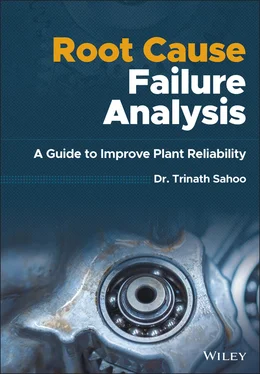Trinath Sahoo - Root Cause Failure Analysis
Здесь есть возможность читать онлайн «Trinath Sahoo - Root Cause Failure Analysis» — ознакомительный отрывок электронной книги совершенно бесплатно, а после прочтения отрывка купить полную версию. В некоторых случаях можно слушать аудио, скачать через торрент в формате fb2 и присутствует краткое содержание. Жанр: unrecognised, на английском языке. Описание произведения, (предисловие) а так же отзывы посетителей доступны на портале библиотеки ЛибКат.
- Название:Root Cause Failure Analysis
- Автор:
- Жанр:
- Год:неизвестен
- ISBN:нет данных
- Рейтинг книги:5 / 5. Голосов: 1
-
Избранное:Добавить в избранное
- Отзывы:
-
Ваша оценка:
- 100
- 1
- 2
- 3
- 4
- 5
Root Cause Failure Analysis: краткое содержание, описание и аннотация
Предлагаем к чтению аннотацию, описание, краткое содержание или предисловие (зависит от того, что написал сам автор книги «Root Cause Failure Analysis»). Если вы не нашли необходимую информацию о книге — напишите в комментариях, мы постараемся отыскать её.
Provides the knowledge and failure analysis skills necessary for preventing and investigating process equipment failures Root Cause Failure Analysis: A Guide to Improve Plant Reliability
Root Cause Failure Analysis: A Guide to Improve Plant Reliability
Root Cause Failure Analysis — читать онлайн ознакомительный отрывок
Ниже представлен текст книги, разбитый по страницам. Система сохранения места последней прочитанной страницы, позволяет с удобством читать онлайн бесплатно книгу «Root Cause Failure Analysis», без необходимости каждый раз заново искать на чём Вы остановились. Поставьте закладку, и сможете в любой момент перейти на страницу, на которой закончили чтение.
Интервал:
Закладка:
Analyzing the short list of potential root causes is to verify each of the suspect causes is essential. In almost all cases, a relatively simple, inexpensive test series can be developed to confirm or eliminate the suspected cause of equipment failure.
Most equipment problems can be traced to misapplication, operating or maintenance practices and procedures. Some of the other causes that are discussed include training, supervision, communications, human engineering, management systems, and quality control. These causes are the most common reasons for poor plant performance and equipment reliability. However, human error may contribute to, or be the sole reason for, the problem.
Recommend and Implement Solution
When working on solutions, keep your Root Cause Analysis aim in view. You don’t just want to solve the immediate problem. You want to prevent the same problem from recurring.
Ask the following questions for finding a solution,
What can you do to prevent the problem from happening again?
How will the solution be implemented?
Who will be responsible for it?
What are the risks of implementing the solution?
A short list of potential corrective action are generated. Each potential corrective action should be carefully scrutinized to determine if it actually will correct the problem. Because many time the analyst Try to fix the symptoms of problems rather than the true root cause. Therefore, care should be taken to evaluate each potential corrective action so that the right one can be implemented to eliminates the real problem. Many a time all corrective actions are not financially justifiable. In some cases, the impact of the incident or event is lower than the cost of the corrective action. In these cases, the RCA should document the incident for future reference, but recommend that no corrective action be taken on some occasions, implementing a temporary solution is the only financially justifiable course of action which can only correct the symptoms. In these instances, the recommendation should clearly define the reason the limitations why this decision was taken and what impact it will have on plant performance.
Also, consider whether the changes you plan to make will impact other areas of your business. Changes to processes can have knock‐on effects. Be sure you aren’t setting yourself up for a new set of problems when you implement the solution. To do this, you need to look at your process flows and how they relate to one another.
The final part of the solution design process is to decide on checks and balances that will tell you whether your business is implementing the solution you’ve devised and whether it works as planned.
Implementation means change, and change must be carefully managed. Everyone concerned needs to know about your solution and the reasoning that led you to believe that you can solve the problem.
So, explain the root cause analysis process and how you arrived at your conclusion. Explain your solution and how you want it to be implemented. Ensure that everyone involved has the knowledge and resources they need to follow through and devise method for testing your new system.
Keep in mind, though, that it’s always better to first apply the solution on a small scale. You can never know what could go wrong. Once you’re certain that the new solution brings results, you can start applying it company‐wide.
Conclusion
When you designed the solution, you decided on key indicators that would allow you to see whether the solution works. Use these indicators to follow up. In this instance, you’re going to see whether the symptoms are gone. The presence or absence of the issues that launched you on your root cause analysis and problem‐solving initiative will tell you whether you have successfully solved the problem. Remember to watch out for new issues that may arise elsewhere as a result of the changes you made.
4 Managing Human Error and Latent Error to Overcome Failure
Everyone can make errors no matter what their level of skill, experience or how well trained and motivated they are. Commonly cited statistics claim that human error is responsible for anywhere between 70 and 100% of failure. Many major failures, e.g. Texas City, Piper Alpha, Chernobyl were contributed by human failure. To enhance reliability, companies need to manage human failure as robustly as they manage technical and engineering failures. It is important to be aware that human failure is not random; understanding why errors occur and the different factors which make them worse will help you develop more effective controls.
Human error was a factor in many highly publicized accidents in recent memory. The costs in terms of human life and money are high. Placing emphasis on reducing human error may help to reduce these costs. This chapter provides an insight view about the causes of human errors and suggests the way to reduce the errors.
Review of Some of the Accidents
Over the last few decades, we have learnt much more about the origins of human failures. The industries/organizations must consider human factor as a distinct element to be assessed and managed effectively in order to control risks. Some of the following accidents of Table 4.1in different sectors provide clues to understand failures.
Table 4.1illustrates how the failure of people at many levels within an organization can contribute to a major disaster. For many of these major accidents, the human failure was not the sole cause but one of a number of causes, including technical and organizational failures, which led to the final outcome. Remember that many “everyday” minor accidents and near misses also involve human failures. All major disasters lead to huge human, property, and environmental losses.
All this evidence shows that human error is a major cause of unreliability or causation of accidents.
Types of Human Failure:
What Types of Errors Do Humans Make?
The consequences of human failures can be immediate or delayed and the failures can be grouped into the following categories:
Table 4.1 Industrial accidents caused by human error.
| Accident, industry and date | consequences | Human contribution and other cause |
|---|---|---|
| Union Carbide Bhopal, 1984 (Chemical Unit) | The plant released a cloud of toxic methyl isocyanate. Death toll was 2500 and over one quarter of the city's population was affected by the gas. | The leak was caused by a discharge of water into a storage tank. This was the result of a combination of operator error, poor maintenance, failed safety systems, and poor safety management. |
| Space Shuttle Challenger 1986 (Aerospace) | An explosion shortly after lift‐off killed all seven astronauts on board | An O‐ring seal on one of the solid rocket boosters split after take‐off releasing a jet of ignited fuel. Inadequate response to internal warnings about the faulty seal design. Decision taken to go for launch in very cold temperature despite faulty seal. Decision‐making result of conflicting scheduling/safety goals, mindset, and effects of fatigue. |
| Piper Alpha 1988 (Offshore) | 167 workers died in the North Sea after a major explosion and fire on an offshore platform | Formal inquiry found a number of technical and organizational failures. Maintenance error that eventually led to the leak was the result of inexperience, poor maintenance procedures, and poor learning by the organization. There was a breakdown in communications and the permit‐to work system at shift changeover, and safety procedures were not practiced sufficiently |
| Texaco Refinery, 1994 (Petroleum Industry | An explosion on the site was followed by a major hydrocarbon fire and a number of secondary fires. There was severe damage to process plant, buildings and storage tanks. 26 people sustained injuries, none serious. | The incident was caused by inflammable hydrocarbon liquid being continuously pumped into a process vessel that had its outlet closed. This was the result of a combination of: an erroneous control system reading of a valve state, modifications which had not been fully assessed, failure to provide operators with the necessary process overviews and attempts to keep the unit running when it should have been shut down. |
Active failures‐ Active failures are the acts or conditions precipitating the incident situation. Active failures have an immediate consequence and are usually made by front‐line people such as drivers, control room staff or machine operators. In a situation where there is no room for error, these active failures have an immediate impact on failure.
Читать дальшеИнтервал:
Закладка:
Похожие книги на «Root Cause Failure Analysis»
Представляем Вашему вниманию похожие книги на «Root Cause Failure Analysis» списком для выбора. Мы отобрали схожую по названию и смыслу литературу в надежде предоставить читателям больше вариантов отыскать новые, интересные, ещё непрочитанные произведения.
Обсуждение, отзывы о книге «Root Cause Failure Analysis» и просто собственные мнения читателей. Оставьте ваши комментарии, напишите, что Вы думаете о произведении, его смысле или главных героях. Укажите что конкретно понравилось, а что нет, и почему Вы так считаете.












